Pernille Ripp's Blog, page 32
April 10, 2018
You Asked For…
Perhaps it is because we woke up to yet more snow on Monday.
Perhaps it is because summer still seems so far away.
Perhaps it is because of too many late nights.
Too little sleep.
State testing.
Friendship drama.
Or simply because 8th grade looms and some kids are not quite sure what that means.
Whatever the reason, this week has been a long one and it is only Tuesday.
From students who are in a state of distress due to things outside of their circumstances.
To friendships cracking, breakups and misunderstandings.
To simply getting to work becoming harder and harder.
To taking more time to settle in.
To more redirections. More jokes needed to get a smile. More energy to get a response.
It is hard. It is draining. It makes me question why I seem to all of a sudden have lost whatever momentum we had and how can I get it back. And do they even know how hard I try? Because, man, I try, every single day to make it an experience worth their time.
Tonight as I pondered how I can help make it better for all of them, it finally dawned on me; they have little to no idea of what I have changed in order to help them. Why should they? I have never shared it. I can hope that they pick up on it, but I wonder if they do, after all, they still have to go to school, they still have to work, and they still have to learn.
So as I pulled up their most recent feedback on our class, I recognized all of the changes made based on their words and then made a few slides. A few visuals for them to see. They simply started with, “You asked for….” and then I filled int heir feedback and then I followed it up with “You got/had…”
You asked for fewer projects, you had only two major projects last quarter.
You asked for less teacher talk, you got lessons that last less than ten minutes.
You asked for more choice in who you work with, you got some degree of choice every single time.
You asked for more choice in projects, you got more than twenty just in the last one.
Two slides filled with many requests all granted; more work time, less homework, less teacher talk, more choice, more freedom, less paper writing and such all filled the slides.
Tomorrow we start the day with a celebration of growth, of freedom, and perhaps even a reminder of just how much they have. Not to elicit guilt but instead build awareness os that we can continue to capitalize on the community we have. On the trust, we have built. On the level of freedom, we may take for granted.
Perhaps we all just need a reminder of just how far we have come.
If you like what you read here, consider reading my newest book, Passionate Readers – The Art of Reaching and Engaging Every Child, out August 2017. This book focuses on the five keys we can implement into any reading community to strengthen student reading experiences, even within the 45 minute English block. If you are looking for solutions and ideas for how to re-engage all of your students consider reading my very first book Passionate Learners – How to Engage and Empower Your Students. Also, if you are wondering where I will be in the coming year or would like to have me speak, please see this page.
Great Picture Books to Discuss Identity and Character
For our entire 4th quarter, we are diving into identity and how it fits within our social comprehension guided by the work of the incredible new book from Sara K. Ahmed, Being the Change. As we start to look at how our identity shapes our actions, I thought a safe spot to start with would be within the pages of picture books. After all, some of my students are not yet ready to share parts of their identity and so looking at the lives of others before we turn inward is a more welcoming path.
I was thrilled to be able to pull so many great nonfiction picture books to have the students read, discuss, and reflect on. The questions we will use to spark conversation include:
What can you infer about their character traits based on their actions?
What can you infer about their identity and what they value?
What do you think motivated them to do what they did?
How do these actions fit into the world from a historical standpoint?
Here are some of the books we are using
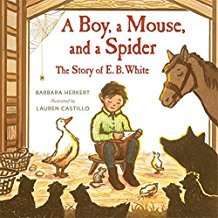
When young Elwyn White lay in bed as a sickly child, a bold house mouse befriended him. When the time came for kindergarten, an anxious Elwyn longed for the farm, where animal friends awaited him at the end of each day. Propelled by his fascination with the outside world, he began to jot down his reflections in a journal. Writing filled him with joy, and words became his world.

Back in the days of long skirts and afternoon teas, young Joan Procter entertained the most unusual party guests: slithery and scaly ones, who turned over teacups and crawled past the crumpets…. While other girls played with dolls, Joan preferred the company of reptiles. She carried her favorite lizard with her everywhere–she even brought a crocodile to school!
When Joan grew older, she became the Curator of Reptiles at the British Museum. She went on to design the Reptile House at the London Zoo, including a home for the rumored-to-be-vicious komodo dragons. There, just like when she was a little girl, Joan hosted children’s tea parties–with her komodo dragon as the guest of honor.

In Mississippi in the mid-1800s, it was illegal for enslaved people to learn to read and write. Getting caught meant thirty-nine lashes with a whip as punishment. But this did not stop Lilly Ann Granderson, an enslaved woman herself. She believed in the power of education. To share her knowledge with others, she started a midnight school. In a small cabin hidden in a back alley, Lilly Ann held her secret classes. Every noise in the dark was a reminder of the punishment she and her students faced if they were found out. But the chance to learn was worth the risk. Over the years, Lilly Ann taught hundreds of enslaved people to read and write. Many of her students went on to share their knowledge with their families. Some started secret schools of their own. Others forged passes to escape to freedom in the North. Based on a true story, Midnight Teacher is an inspiring testament to a little-known pioneer in education.
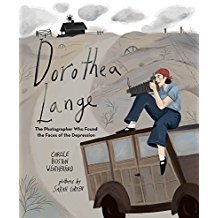
Before she raised her lens to take her most iconic photo, Dorothea Lange took photos of the downtrodden from bankers in once-fine suits waiting in breadlines, to former slaves, to the homeless sleeping on sidewalks. A case of polio had left her with a limp and sympathetic to those less fortunate. Traveling across the United States, documenting with her camera and her fieldbook those most affected by the stock market crash, she found the face of the Great Depression

Dangerous Jane by Suzanne Slade (Author), Alice Ratterree (Illustrator)
Jane’s heart ached for the world, but what could she do to stop a war?
This energetic and inspiring picture book biography of activist Jane Addams focuses on the peace work that won her the Nobel Peace Prize. From the time she was a child, Jane’s heart ached for others. At first the focus of her efforts was on poverty, and lead to the creation of Hull House, the settlement house she built in Chicago. For twenty-five years, she’d helped people from different countries live in peace at Hull House. But when war broke out, Jane decided to take on the world and become a dangerous woman for the sake of peace.
A bilingual biography of José Martí, who dedicated his life to the promotion of liberty, the abolishment of slavery, political independence for Cuba, and intellectual freedom. Written in verse with excerpts from Martí’s seminal work, Versos sencillos.

On the morning of August 6, 1926, Gertrude Ederle stood in her bathing suit on the beach at Cape Gris-Nez, France, and faced the churning waves of the English Channel. Twenty-one miles across the perilous waterway, the English coastline beckoned. Lyrical text, stunning illustrations and fascinating back matter put the reader right alongside Ederle in her bid to be the first woman to swim the Channel―and contextualizes her record-smashing victory as a defining moment in sports history. Time line, bibliography, source notes.
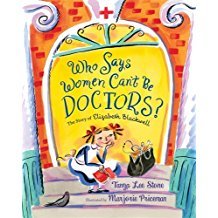 Who Says Women Can’t Be Doctors?: The Story of Elizabeth Blackwell by Tanya Lee Stone (Author)
Who Says Women Can’t Be Doctors?: The Story of Elizabeth Blackwell by Tanya Lee Stone (Author)
In the 1830s, when a brave and curious girl named Elizabeth Blackwell was growing up, women were supposed to be wives and mothers. Some women could be teachers or seamstresses, but career options were few. Certainly no women were doctors.
But Elizabeth refused to accept the common beliefs that women weren’t smart enough to be doctors, or that they were too weak for such hard work. And she would not take no for an answer. Although she faced much opposition, she worked hard and finally―when she graduated from medical school and went on to have a brilliant career―proved her detractors wrong. This inspiring story of the first female doctor shows how one strong-willed woman opened the doors for all the female doctors to come.

Before She was Harriet by Lesa Cline-Ransome (Author), James E. Ransome (Illustrator)
We know her today as Harriet Tubman, but in her lifetime she was called by many names. As General Tubman she was a Union spy. As Moses she led hundreds to freedom on the Underground Railroad. As Minty she was a slave whose spirit could not be broken. An evocative poem and opulent watercolors come together to honor a woman of humble origins whose courage and compassion make her larger than life.

Chef Roy Choi calls himself a “street cook.”
He wants outsiders, low-riders,
kids, teens, shufflers and skateboarders,
to have food cooked with care, with love,
with sohn maash.
“Sohn maash” is the flavors in our fingertips. It is the love and cooking talent that Korean mothers and grandmothers mix into their handmade foods. For Chef Roy Choi, food means love. It also means culture, not only of Korea where he was born, but the many cultures that make up the streets of Los Angeles, where he was raised. So remixing food from the streets, just like good music—and serving it up from a truck—is true to L.A. food culture. People smiled and talked as they waited in line. Won’t you join him as he makes good food smiles?
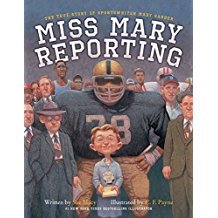
While sitting in the bleachers of a Soap Box Derby in the 1950s, Mary Garber overheard two African-American boys in the following exchange: “See that lady down there?” asked one boy. “That’s Mary Garber. She doesn’t care who you are, but if you do something good, she’ll write about you.”
Mary Garber was a pioneering sports journalist in a time where women were rarely a part of the newspaper business. Women weren’t even allowed to sit in the press boxes at sporting events, so Mary was forced to sit with the coaches’ wives. But that didn’t stop her.
In a time when African-American sports were not routinely covered, Mary went to the games and wrote about them. Garber was a sportswriter for fifty-six years and was the first woman to receive the Associated Press Sports Editors’ Red Smith Award, presented for major contributions in sports journalism. And now, every year the Association of Women in Sports Media presents the Mary Garber Pioneer Award in her honor to a role model for women in sports media.
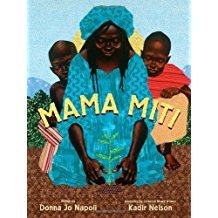
Through artful prose and beautiful illustrations, Donna Jo Napoli and Kadir Nelson tell the true story of Wangari Muta Maathai, known as “Mama Miti,” who in 1977 founded the Green Belt Movement, an African grassroots organization that has empowered many people to mobilize and combat deforestation, soil erosion, and environmental degradation. Today more than 30 million trees have been planted throughout Mama Miti’s native Kenya, and in 2004 she became the first African woman to win the Nobel Peace Prize. Wangari Muta Maathai has changed Kenya tree by tree—and with each page turned, children will realize their own ability to positively impact the future.

Marie Curie by Demi (Author, Illustrator)
Maria Salomea Sklodowaska was born on November 7, 1867. Her family called her Manya, but the world would remember her by another name: Marie Curie, one of the greatest scientists who ever lived.
In a time when few women attended college, Marie earned degrees in physics and mathematics and went on to discover two elements: radium and polonium. She also invented a new word along the way: radioactive. This book celebrates her momentous achievements while also educating its readers about her scientific accomplishments and their implications.
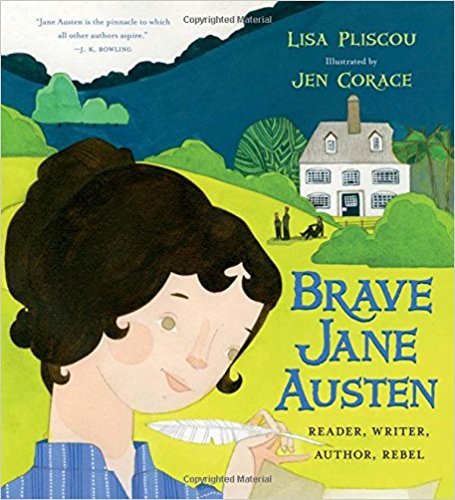
Brave Jane Austen: Reader, Writer, Author, Rebel by Lisa Pliscou (Author), Jen Corace (Illustrator)
Born in the late 1700s, Jane Austen was a smart, creative girl in a house full of boys, all of whom could aspire to accomplish many things as adults while girls were raised primarily to become good wives. Jane didn’t have much opportunity to go to school but she read everything she could, including all the books in her father’s study. And before long, she began to write her own stories, filled with funny, clever, and inventive characters.

Harlem’s Little Blackbird: The Story of Florence Mills by Renee Watson (Author), Christian Robinson (Illustrator)
Born to parents who were both former slaves, Florence Mills knew at an early age that she loved to sing, and that her sweet, bird-like voice, resonated with those who heard her. Performing catapulted her all the way to the stages of 1920s Broadway where she inspired everyone from songwriters to playwrights. Yet with all her success, she knew firsthand how prejudice shaped her world and the world of those around her. As a result, Florence chose to support and promote works by her fellow black performers while heralding a call for their civil rights. Featuring a moving text and colorful illustrations, Harlem’s Little Blackbird is a timeless story about justice, equality, and the importance of following one’s heart and dreams.

The Legendary Miss Lena Horne by Carole Boston Weatherford (Author), Elizabeth Zunon (Illustrator)
You have to be taught to be second class; you’re not born that way.
Lena Horne was born into the freedom struggle, to a family of teachers and activists. Her mother dreamed of being an actress, so Lena followed in her footsteps as she chased small parts in vaudeville, living out of a suitcase until MGM offered Lena something more—the first ever studio contract for a black actress.
But the roles she was considered for were maids and mammies, stereotypes that Lena refused to play. Still, she never gave up. “Stormy Weather” became her theme song, and when she sang “This Little Light of Mine” at a civil rights rally, she found not only her voice, but her calling.

Before Supreme Court Justice Sonia Sotomayor took her seat in our nation’s highest court, she was just a little girl in the South Bronx. Justice Sotomayor didn’t have a lot growing up, but she had what she needed — her mother’s love, a will to learn, and her own determination. With bravery she became the person she wanted to be. With hard work she succeeded. With little sunlight and only a modest plot from which to grow, Justice Sotomayor bloomed for the whole world to see.

Who was Grace Hopper? A software tester, workplace jester, cherished mentor, ace inventor, avid reader, naval leader—AND rule breaker, chance taker, and troublemaker. Acclaimed picture book author Laurie Wallmark (Ada Byron Lovelace and the Thinking Machine) once again tells the riveting story of a trailblazing woman. Grace Hopper coined the term “computer bug” and taught computers to “speak English.” Throughout her life, Hopper succeeded in doing what no one had ever done before. Delighting in difficult ideas and in defying expectations, the insatiably curious Hopper truly was “Amazing Grace” . . . and a role model for science- and math-minded girls and boys. With a wealth of witty quotes, and richly detailed illustrations, this book brings Hopper’s incredible accomplishments to life.

To become the first female Jewish Supreme Court Justice, the unsinkable Ruth Bader Ginsburg had to overcome countless injustices. Growing up in Brooklyn in the 1930s and ’40s, Ginsburg was discouraged from working by her father, who thought a woman’s place was in the home. Regardless, she went to Cornell University, where men outnumbered women four to one. There, she met her husband, Martin Ginsburg, and found her calling as a lawyer. Despite discrimination against Jews, females, and working mothers, Ginsburg went on to become Columbia Law School’s first tenured female professor, a judge for the US Court of Appeals, and finally, a Supreme Court Justice.

To the Stars!: The First American Woman to Walk in Space by Carmella Van Vleet (Author), Dr. Kathy Sullivan (Author), Nicole Wong (Illustrator)
Kathy Sullivan wanted to go everywhere. She loved blueprints and maps. She loved languages and the ocean. She didn’t like the question, “What do you want to be when you grow up?” She wanted to explore and do exciting things that girls weren’t supposed to be able to do. Only men had the exciting jobs.
Kathy liked fishing and swimming; flying planes and studying science. That’s what she liked and that’s what she decided to do with her life. She followed her heart and eventually became a NASA astronaut and the first woman to walk in space. Kathy wanted to see the whole world and so she did: from space!

Zaha Hadid grew up in Baghdad, Iraq, and dreamed of designing her own cities. After studying architecture in London, she opened her own studio and started designing buildings. But as a Muslim woman, Hadid faced many obstacles. Determined to succeed, she worked hard for many years, and achieved her goals—and now you can see the buildings Hadid has designed all over the world.

Radiant Child: The Story of Young Artist Jean-Michel Basquiat by Javaka Steptoe (Author)
Jean-Michel Basquiat and his unique, collage-style paintings rocketed to fame in the 1980s as a cultural phenomenon unlike anything the art world had ever seen. But before that, he was a little boy who saw art everywhere: in poetry books and museums, in games and in the words that we speak, and in the pulsing energy of New York City. Now, award-winning illustrator Javaka Steptoe’s vivid text and bold artwork echoing Basquiat’s own introduce young readers to the powerful message that art doesn’t always have to be neat or clean–and definitely not inside the lines–to be beautiful.

Danza!: Amalia Hernández and Mexico’s Folkloric Ballet by Duncan Tonatiuh (Author)
Danza! is a celebration of Hernández’s life and of the rich history of dance in Mexico. As a child, Amalia always thought she would grow up to be a teacher, until she saw a performance of dancers in her town square. She was fascinated by the way the dancers twirled and swayed, and she knew that someday she would be a dancer, too. She began to study many different types of dance, including ballet and modern, under some of the best teachers in the world. Hernández traveled throughout Mexico studying and learning regional dances. Soon she founded her own dance company, El Ballet Folklórico de México, where she integrated her knowledge of ballet and modern dance with folkloric dances. The group began to perform all over the country and soon all over the world, becoming an international sensation that still tours today.

Born in Ghana, West Africa, with one deformed leg, he was dismissed by most people—but not by his mother, who taught him to reach for his dreams. As a boy, Emmanuel hopped to school more than two miles each way, learned to play soccer, left home at age thirteen to provide for his family, and, eventually, became a cyclist. He rode an astonishing four hundred miles across Ghana in 2001, spreading his powerful message: disability is not inability. Today, Emmanuel continues to work on behalf of the disabled.
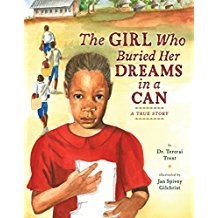
All the girl ever wanted was an education. But in Rhodesia, education for girls was nearly impossible.
So she taught herself to read and write with her brother’s schoolbooks and to count while watching cattle graze.
When the girl became a young wife and mother, she wrote her goals on a scrap of paper and buried them in a can—an ancient ritual that reminded her that she couldn’t give up on her dreams.
She dreamed of going to America and earning one degree; then a second, even higher; and a third, the highest. And she hoped to bring education to all the girls and boys of her village.
Would her dreams ever come true?

Diego Rivera: His World and Ours by Duncan Tonatiuh (Author)
This charming book introduces one of the most popular artists of the twentieth century, Diego Rivera, to young readers. It tells the story of Diego as a young, mischievous boy who demonstrated a clear passion for art and then went on to become one of the most famous painters in the world.
Duncan Tonatiuh also prompts readers to think about what Diego would paint today. Just as Diego’s murals depicted great historical events in Mexican culture or celebrated native peoples, if Diego were painting today, what would his artwork depict? How would his paintings reflect today’s culture?
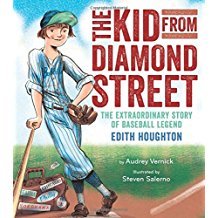
Beginning in 1922, when Edith Houghton was only ten years old, she tried out for a women’s professional baseball team, the Philadelphia Bobbies. Though she was the smallest on the field, soon reporters were talking about “The Kid” and her incredible skill, and crowds were packing the stands to see her play. Her story reminds us that baseball has never been about just men and boys. Baseball is also about talented girls willing to work hard to play any way they can.
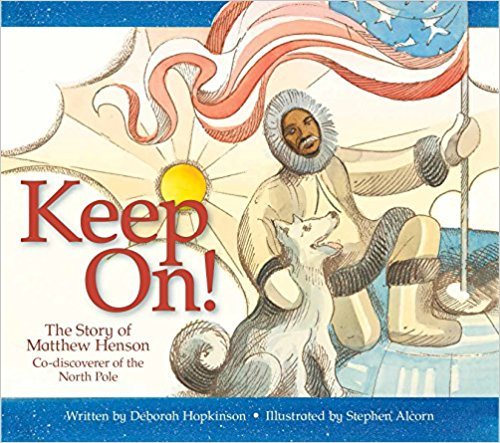
Many know the story of Robert Peary’s great 1909 expedition to reach the North Pole. Yet few people know that Peary was joined on this grueling, history-making journey by fellow explorer Matthew Henson. Henson was born just after the Civil War, a time when slavery had been abolished, but few opportunities were available for black people. Even as a child, he exhibited a yearning for adventure, and at the age of only thirteen, he embarked on a five-year voyage sailing the seven seas and learning navigation, history, and mathematics. Henson’s greatest adventure began when he accepted an invitation from Robert Peary to join his expedition to the North Pole. The team endured storms, shifting ice, wind, injuries, accidents, and unimaginable cold. Finally on April 1, Peary, Henson, and four Inuit men began the final 133-mile push to the Pole.
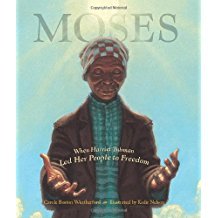
This poetic book is a resounding tribute to Tubman’s strength, humility, and devotion. With proper reverence, Weatherford and Nelson do justice to the woman who, long ago, earned over and over the name Moses.

Ernie Barnes was an NFL football player who longed to make art. Finally his dream came true.
When Ernie Barnes was growing up in North Carolina in the 1940s, he loved to draw. Even when he played as a boy with his friends he drew with a stick in the mud. And he never left home without a sketchbook. He would draw families walking home from church, or the old man on the sofa. He drew what he saw.
But in the segregated south, Ernie didn’t know how to make a living as an artist. Ernie grew tall and athletic and became a football star. Soon enough the colleges came calling. Still, in his heart Ernie longed to paint. Would that day ever come?
Ernie Barnes was one of the most important artists of his time known for his style of elongation and movement. His work has influenced a generation of painters and illustrators and can be found in museums and collections, such as the African American Museum in Philadelphia and the California African American Museum.
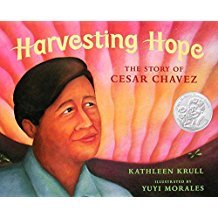
Harvesting Hope: The Story of Cesar Chavez by Kathleen Krull (Author), Yuyi Morales (Illustrator)
Cesar Chavez is known as one of America’s greatest civil rights leaders. When he led a 340-mile peaceful protest march through California, he ignited a cause and improved the lives of thousands of migrant farmworkers. But Cesar wasn’t always a leader. As a boy, he was shy and teased at school. His family slaved in the fields for barely enough money to survive.
Cesar knew things had to change, and he thought that–maybe–he could help change them. So he took charge. He spoke up. And an entire country listened.

Nine-year-old Audrey Faye Hendricks intended to go places and do things like anybody else.
So when she heard grown-ups talk about wiping out Birmingham’s segregation laws, she spoke up. As she listened to the preacher’s words, smooth as glass, she sat up tall. And when she heard the plan—picket those white stores! March to protest those unfair laws! Fill the jails!—she stepped right up and said, I’ll do it! She was going to j-a-a-il!
Audrey Faye Hendricks was confident and bold and brave as can be, and hers is the remarkable and inspiring story of one child’s role in the Civil Rights Movement.
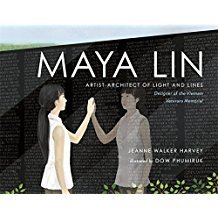
You may be familiar with the iconic Vietnam Veterans Memorial. But do you know about the artist-architect who created this landmark?
As a child, Maya Lin loved to study the spaces around her. She explored the forest in her backyard, observing woodland creatures, and used her house as a model to build tiny towns out of paper and scraps. The daughter of a clay artist and a poet, Maya grew up with art and learned to think with her hands as well as her mind. From her first experiments with light and lines to the height of her success nationwide, this is the story of an inspiring American artist: the visionary artist-architect who designed the Vietnam Veterans Memorial.

Trombone Shorty by Troy Andrews (Author), Bryan Collier (Illustrator)
Hailing from the Tremé neighborhood in New Orleans, Troy “Trombone Shorty” Andrews got his nickname by wielding a trombone twice as long as he was high. A prodigy, he was leading his own band by age six, and today this Grammy-nominated artist headlines the legendary New Orleans Jazz Fest.
Along with esteemed illustrator Bryan Collier, Andrews has created a lively picture book autobiography about how he followed his dream of becoming a musician, despite the odds, until he reached international stardom. Trombone Shorty is a celebration of the rich cultural history of New Orleans and the power of music.

You know the Super Soaker. It’s one of top twenty toys of all time. And it was invented entirely by accident. Trying to create a new cooling system for refrigerators and air conditioners, impressive inventor Lonnie Johnson instead created the mechanics for the iconic toy.
A love for rockets, robots, inventions, and a mind for creativity began early in Lonnie Johnson’s life. Growing up in a house full of brothers and sisters, persistence and a passion for problem-solving became the cornerstone for a career as an engineer and his work with NASA. But it is his invention of the Super Soaker water gun that has made his most memorable splash with kids and adults.
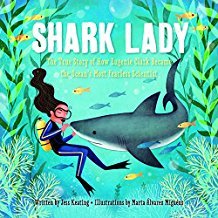
Eugenie Clark fell in love with sharks from the first moment she saw them at the aquarium. She couldn’t imagine anything more exciting than studying these graceful creatures. But Eugenie quickly discovered that many people believed sharks to be ugly and scary―and they didn’t think women should be scientists.
Determined to prove them wrong, Eugenie devoted her life to learning about sharks. After earning several college degrees and making countless discoveries, Eugenie wrote herself into the history of science, earning the nickname “Shark Lady.” Through her accomplishments, she taught the world that sharks were to be admired rather than feared and that women can do anything they set their minds to.

I Am Jazz by Jessica Herthel (Author), Jazz Jennings (Author), Shelagh McNicholas (Illustrator)
From the time she was two years old, Jazz knew that she had a girl’s brain in a boy’s body. She loved pink and dressing up as a mermaid and didn’t feel like herself in boys’ clothing. This confused her family, until they took her to a doctor who said that Jazz was transgender and that she was born that way. Jazz’s story is based on her real-life experience and she tells it in a simple, clear way that will be appreciated by picture book readers, their parents, and teachers.

A Boy and a Jaguar by Alan Rabinowitz (Author), Catia Chien (Illustrator)
Alan loves animals, but the great cat house at the Bronx Zoo makes him sad. Why are they all alone in empty cages? Are they being punished? More than anything, he wants to be their champion—their voice—but he stutters uncontrollably.
Except when he talks to animals…
Then he is fluent.
Follow the life of the man Time Magazine calls, “the Indiana Jones of wildlife conservation”as he searches for his voice and fulfills a promise to speak for animals, and people, who cannot speak for themselves.

Girl Running by Annette Bay Pimentel (Author), Micha Archer (Illustrator)
Because Bobbi Gibb is a girl, she’s not allowed to run on her school’s track team. But after school, no one can stop her–and she’s free to run endless miles to her heart’s content. She is told no yet again when she tries to enter the Boston Marathon in 1966, because the officials claim that it’s a man’s race and that women are just not capable of running such a long distance. So what does Bobbi do? She bravely sets out to prove the naysayers wrong and show the world just what a girl can do.

Hiawatha and the Peacemaker by Robbie Robertson (Author), David Shannon (Illustrator)
Born of Mohawk and Cayuga descent, musical icon Robbie Robertson learned the story of Hiawatha and his spiritual guide, the Peacemaker, as part of the Iroquois oral tradition. Now he shares the same gift of storytelling with a new generation.
Hiawatha was a strong and articulate Mohawk who was chosen to translate the Peacemaker’s message of unity for the five warring Iroquois nations during the 14th century. This message not only succeeded in uniting the tribes but also forever changed how the Iroquois governed themselves—a blueprint for democracy that would later inspire the authors of the U.S. Constitution.

Malcolm X grew to be one of America’s most influential figures. But first, he was a boy named Malcolm Little. Written by his daughter, this inspiring picture book biography celebrates a vision of freedom and justice.
Bolstered by the love and wisdom of his large, warm family, young Malcolm Little was a natural born leader. But when confronted with intolerance and a series of tragedies, Malcolm’s optimism and faith were threatened. He had to learn how to be strong and how to hold on to his individuality. He had to learn self-reliance.
And there you have it, just a few of the books we will be suing to discuss identity, motivation, and character.
If you want to see more of our favorite books, go here.
April 9, 2018
Hold Your Tongue
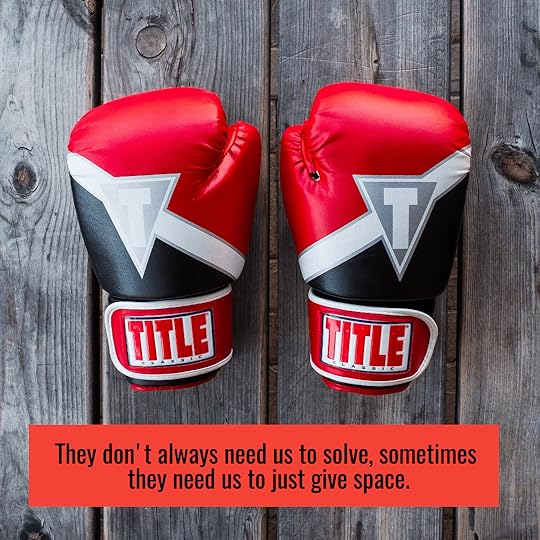
He sits with his head slumped down. Again. Nothing in front of him. Again. Eyes are closed. Again. Arms crossed as he lays his head on the table. Again.
To a person walking by he looks like he is asleep.
To me, he looks like he is mad. Actively fighting me and what we are doing. Again….
But I wait…ask him again if he is okay. If he needs anything.
He doesn’t answer.
My patience runs thin, after all I have a class to get to. To teach. Why can’t he just answer? I am trying to help after all. Again.
He can tell probably that my answers are getting shorter. Less calm in my voice. And yet, he continues to refuse. Tells me it’s not worth his time. That he doesn’t want to do it. Looks for the holes in my teacher armor and shoots to kill with every word he can think of.
I take it in, knowing now is not the time to fight, and yet it is so hard until I remember to walk away.
To hold my tongue and give some space. To not guess at what is happening and draw the wrong conclusions, but instead just give time. Not to try to solve. Not to try to fix. Not try to be right there actively problem-solving, trying to get to the bottom of it all. Instead walking away before I forget what every kid needs; a shoulder, an ear, some time, some space.
And even though every ounce of my teacher mind tells me to come back to him, to try to fix it, to try again, I stay away. I just watch, take no action, and wait…
And so five minutes later or perhaps even ten, I see his head is up. He is reading, sort of, he is kind of working. No longer shut down, but at least alert. Is it perfect? Nope. Is it enough? Nope. Is it a breakthrough? Nope, not really, but it is a start, and sometimes that is all we need.
Tomorrow we try again, not stuck in a power struggle, but at least in a place of truce. In a place where we can both exist and hopefully move an inch further forward toward something that looks like learning, like trust.
Once again, I am reminded of how powerful silence and space can be. Especially when they expect us to do neither. Again.
If you like what you read here, consider reading my newest book, Passionate Readers – The Art of Reaching and Engaging Every Child, out August 2017. This book focuses on the five keys we can implement into any reading community to strengthen student reading experiences, even within the 45 minute English block. If you are looking for solutions and ideas for how to re-engage all of your students consider reading my very first book Passionate Learners – How to Engage and Empower Your Students. Also, if you are wondering where I will be in the coming year or would like to have me speak, please see this page.
April 8, 2018
After the Bullying Ends
Many have asked how our daughter is. Whether the bullying has stopped? Whether she is okay.
And to that I say, it’s complicated.
The short answer is, yes, the bullying has stopped. After further incidents where Thea once again was targeted, was hurt both physically and emotionally, the girl who continued to seek her out was removed from her classroom and so it stopped. They don’t see each other and so there has been no room for any kind of incidents to happen.
The long answer though is different. Sure, Thea is no longer in an active bullying situation but as any parent of a child who has experienced trauma will tell you, it is not over.
Her foundational belief that school is safe for her is gone.
Her belief that adults can keep her safe is being rebuilt.
Her positive attitude toward school and what it entails to be a student is often missing.
Instead, we are left with a child who sometimes still asks to not go to school and wonders what will happen if…
What will happen if they target me again?
What will happen if they hit me?
What will happen if no one likes me?
What will happen if my teacher doesn’t believe me?
And whenever we need to, we remind her that we are here to help. That her teachers are there to help. That we have a plan. That we have a system in place.
And yet, telling a child that you have a plan who has already witnessed that plan failing to protect them seems cruel at times and laughable at others.
And yet she goes to school. She laughs with her friends. She smiles about boys (where did that come from?), she tells me of her interest in Rosa Parks and how one day she hopes to be as brave as her. She shares the good, the trivial, and sometimes the bad. We speak of before and after, having found a new time marker in our life that we never wanted. We speak of next year and wonder whether 3rd grade was just a year to forget and that next year certainly must be better.
Her father and I wonder what the long-term changes will be. Will she continue to distrust school? Will she continue to reach fight, flight, or freeze much faster than her siblings? Will she continue to wonder when someone says or does something unkind to her whether they will repeat it and a new bullying situation will happen?
I wish I could say that it’s over and that she is fine.
There are days I believe it but then there are days where we see the pain from it all rear its ugly head again and we are left to pick up the pieces of a kid who so much wants to love school, to be successful, to be liked. But who just doesn’t know if it will happen.
So all I can say, to those who have wondered. It’s better, we believe that, but we still have a long way to go. And our daughter? She continues to amaze us because that is all she ever has been; amazing. And tough. And kind. No child should have to experience bullying, what can we do to stop it?
April 7, 2018
One More Time for the People in the Back
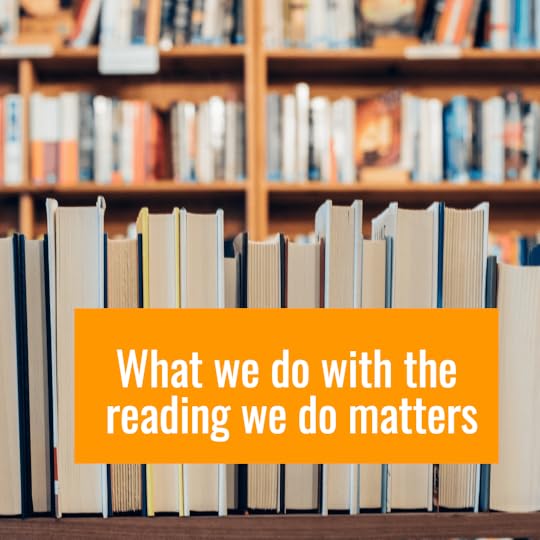
I don’t think that I can yell any louder.
How many times that I have repeated myself on this blog.
How many times I have repeated the voices of those who speak the words loudly, of those who spoke the words long before I ever did.
I don’t think I can say it in other ways than I have, but I suppose one more time for good measure. For the people in the back of the room, or for those who just showed up.
If we want to help kids like reading we need to surround them with books.
If we want to help kids like reading we need to give them time to actually read.
If we want to help kids like reading we need to create a community of readers.
If we want to help kids like reading we need to help them develop their reader identity.
We need to help them go beyond our help.
We need to help them go beyond their level.
Their Lexile.
Their data.
The computer program that tells them what they can do or not do as a reader.
We need them to see worth in what they are doing and worth in who reading helps them become.
We need to help them see that reading matters beyond the journal entry, beyond the project, beyond the thing we just made them do to prove that they are actually reading.
We need to speak books.
To share books.
To have books that show them who they are and also what others are.
To celebrate books and all types of reading so that within our classrooms and schools every child can see themselves as a kid who reads. As a kid whose reading matters. As a kid who doesn’t read “easy” books, who doesn’t cheat in reading when they listen to audio books. As a kid who might not just be a reader someday, completely dismissing that they are, indeed, already a reader.
And not just in their own eyes but in our eyes as well.
So I suppose I can say it one more time; what we do with the reading we do matters.
What we don’t do with the reading we do matters.
The identities we help create matter.
And the words our students share about what is killing their love of reading matters. the least we can do is listen to them.
And we must bring back common sense reading practices to protect the very kids whose reading lives we were told to nurture, to protect, and to grow.
Perhaps you will join in the yelling and the powers that may be will one day hear us.
If you like what you read here, consider reading my newest book, Passionate Readers – The Art of Reaching and Engaging Every Child, out August 2017. This book focuses on the five keys we can implement into any reading community to strengthen student reading experiences, even within the 45 minute English block. If you are looking for solutions and ideas for how to re-engage all of your students consider reading my very first book Passionate Learners – How to Engage and Empower Your Students. Also, if you are wondering where I will be in the coming year or would like to have me speak, please see this page.
April 6, 2018
One Week Into a Phone Free Classroom
We went phone free in our classroom five days ago. Five days of no phones allowed. Five days of fewer distractions. Five days of being conscious of when we pull out a device, and when we purposely put it away. Over spring break, I had sent the following email to students and parents letting them know of the decision, worried about the top-down approach I was taking with this decision. And yet, I felt like we had to try something new and now was the time for the change.
I hope your spring break has been nice! Just a heads up that we will be going phone free for most of the 4th quarter in both literacy studies and informational studies in our classroom, as well as independent reading. Students will be asked to leave their phones in their lockers on in a basket on our shelf as they enter the room.
There are a few reasons I have made this decision:
While there will be times we will use our phones and with the accessibility of Chromebooks, there are very few times where students need to BYOD anymore.
Students are given little privacy or room for risk/failure in our classrooms as other students are quick to pull out their phones and snap pictures or videos to share on social media. Often they are faster than we are or do it on the sly, this leads to less risk-taking, and a heightened sense of anxiety when it comes to actually doing the learning.
One article here discusses how even having it nearby versus out of the room lessens your thinking.
Another article here discusses how the constant stimuli from phones are rewiring our brains to constantly seek stimuli rather than dive into the “zone of learning”
And another article discusses the shortened attention spans
If messages need to be sent to your students during our class together, they can be sent through the office.
While I didn’t know what the response would be, I was pleasantly surprised to see just how many parents/guardians loved the idea, how many wish we would go phone free as a class, how many were in favor. And yet, how would the students themselves react?
Well, it turns out many of them read the email and already were onboard when they came. A few had questions, but most agreed that it was nice. So the week went on, the phones disappeared and we dug into our new learning I noticed there was less scrambling to get to work. Less distractions from the few kids that would pull them out to check throughout the class. My phone was in my bag as well, sure, there were less pictures shared of our learning but not having it around was really not a big deal. Today I asked them what they thought of the policy. Boy, was I surprised…
I think it’s fair because we don’t need them.
I like it because I don’t get distracted.
It is nice to not have to think about them.
It’s no big deal.
I am grateful for it because I no longer have to worry about being filmed and it shared on Instagram.
Sure, a few voiced their complaints telling me they didn’t like to be without them, these were also some of the kids that were distracted by their phones the most playing fortnite or snapchatting in class, while a few voiced that they didn’t really need the policy because they already left them in their lockers.
What struck me though was how many students were positive about the change. How many were grateful for the policy because they then didn’t need to police themselves. It makes sense in a way too as we see just how addicted we, adults, are to our smartphones. When they aren’t allowed to be around we naturally use them less and yet have a hard time putting them away ourselves.
One comment that did stand out though was that a child didn’t like being without their phone in case something bad happened at school. Let’s just have that sink in for a moment… In an age of school shootings, schools are no longer viewed as safe by the very kids we teach and cell phones are seen as a way to find out when they need to run or hide.
So this first week of no phones, it turns out that perhaps going without was not that big of a deal, once again making me wonder what we really needed them for in the first place. It has been nice to have this one less thing in our classroom. To see the students focus on each other, rather than on what is happening on their phone. To see them be more present if even for a little bit.
I’ll keep sharing as the quarter goes on, but I have a feeling that going phone free is here to stay.
If you like what you read here, consider reading my newest book, Passionate Readers – The Art of Reaching and Engaging Every Child, out August 2017. This book focuses on the five keys we can implement into any reading community to strengthen student reading experiences, even within the 45 minute English block. If you are looking for solutions and ideas for how to re-engage all of your students consider reading my very first book Passionate Learners – How to Engage and Empower Your Students. Also, if you are wondering where I will be in the coming year or would like to have me speak, please see this page.
April 5, 2018
How We Grow
They tell me to speak less.
To give less reading time.
To give more reading time.
To do more fun stuff.
To do more hands-on activities.
To grow.
To remain the same.
I survey my students periodically. Whether it surrounds their reading habits, their self-assessments, their view of our classroom, or even their attitudes, surveys are a part of our learning journey. They have been for many years. In fact, I owe most of my growth and this blog to the words of my students.
One of the teaching points for me is always that they must put their name on the survey, no anonymity in here, after all, even if they have harsh things to say, they need to find a way to say it without intentional hurt. Their name on the survey provides me with a chance to follow up. To thank them for their honesty. To wonder aloud how can I make their experience better. To brainstorm or simply connect dependent on their needs. I need to see how our classroom is perceived by individuals, rather than just the group.
So yesterday, after they filled in this attitude survey, one thing stood out above all; we want more hands-on activities. No surprise there, “hands-on” seems to be the key term whenever I speak to students. And yet, I try… Along with my colleagues and the students themselves, we try to plan for movement, for less teacher talk, for activities that excite rather than just sit-and-get and yet; but at the end of the day I still wondered; how do we make reading and writing more hands-on, and what does that even mean?
So today, I asked again; what do you mean? How can we make our class more hands-on, and the kids responded in kind; more talking, more group projects, more competition at times, even more project choice. So not what I expected at all. What they want is more student time, less teacher time. More choice beyond the choices they already have.
Certainly, we can do that.
And that’s the thing, every single time I give a survey, I grow. Every single time, I ask for feedback, our students point out the direction that they would like us to take. They increase ownership and I get to be a more responsive teacher. It is a win-win, even if at times, their surveys show dissatisfaction. Show that they don’t love the class. Show that there are still many things I can work on. Bottom line though is that if we don’t ask, we won’t know. If we don’t take a deep breath and hold on to the notion that we are not perfect teachers, then we cannot become better. No PD opportunity will ever beat the opportunity of growth that our students provide.
So if you give a survey, and I so hope you do, don’t forget though to follow up. Don’t guess at their answers. Don’t guess at their reasoning. Have them put their name on it and then ask them what they mean. When we remove the assumptions from our classrooms, we only grow stronger as educators. Once again, our students are here to teach us if only we give them a chance.
If you like what you read here, consider reading my newest book, Passionate Readers – The Art of Reaching and Engaging Every Child, out August 2017. This book focuses on the five keys we can implement into any reading community to strengthen student reading experiences, even within the 45 minute English block. If you are looking for solutions and ideas for how to re-engage all of your students consider reading my very first book Passionate Learners – How to Engage and Empower Your Students. Also, if you are wondering where I will be in the coming year or would like to have me speak, please see this page.
April 3, 2018
The 30-Second Book Talk
Student book talks are one of the many ways that students share recommendations for each other. Recommendations of books are a natural way to grow readers and they help immensely in the classroom when peers can hear from each other rather than just recommendations from me.
In the past, I would often ask kids if anyone had a book to recommend and yet it seemed that it was always the same awesome students who felt brave enough to recommend their books in front of the whole class. There is just something about 7th grade that makes even the boldest kids shy.
So rather than limit the book talks or force kids, we created the 30-second book talk. Yes, some kids still get nervous, but now they are prepared rather than feeling like they are coming up with something on the spot.
The idea is super simple. Every student gets a notecard, on it, they write a brief recommendation of the book they want to share. They can talk about the book and why it is a great read and who may like it as well. Their names go on the book and then they hand the cards to me.
[image error]
Every day, when we remember, or sometimes just when we have a little bit of extra time, I pull a few cards from the stack as students enter. I then have the book covers ready to be projected, I give the card back to the student as a way to let them know they will recommend today and then we are off after their independent reading time. This gives the kids recommending a few minutes to read their book talk and adjust if needed. Kids read off their cards if they want or they invent on the spot. Their peers have their to-be-read lists out and add as they hear great titles shared. The book cover is projected so everyone can see the title and author and the intimidation factor is lessened.
Because we have so many students, these cards usually take us at least two weeks to go through and then we can do another round if we choose to.
There you go, another simple idea to create more passionate readers.
PS: You want to see some of our favorite books, go here
If you like what you read here, consider reading my newest book, Passionate Readers – The Art of Reaching and Engaging Every Child, out August 2017. This book focuses on the five keys we can implement into any reading community to strengthen student reading experiences, even within the 45 minute English block. If you are looking for solutions and ideas for how to re-engage all of your students consider reading my very first book Passionate Learners – How to Engage and Empower Your Students. Also, if you are wondering where I will be in the coming year or would like to have me speak, please see this page.
April 2, 2018
Who Keeps You In Line?
On Friday, I stood on the stage at EARCOS in front of hundreds of passionate educators from all over Asia and told them my story of change. The story of how my students have changed me. It was met with applause, with careful words shared after about how they felt inspired, moved, how what I had said mattered and how they wish more educators had been there to hear this powerful message. I felt on top of the world. As if I mattered, as if the words I spoke mattered, as if I had made a difference. Like I had it all figured out.
[image error]
Today, some of my students reminded me that our class is boring, that what we are doing doesn’t matter much, and that no, they were not happy to be back after spring break, thank you very much. Ah, the life of teaching 7th grade.
So much changes in a few days.; from high praise, hugs, and admiration from fellow educators to sometimes harsh words served up frankly from the very students I serve.
It seems that I am not the perfect teacher after all, but I knew that already, even before today, because I teach students who speak up. Who sometimes forget to say the nice before they get straight to the point. Who have no problem pointing out what they dislike, but still are working on how we can make things better together. Who, yes, sometimes like our class, but often push me to be better, to try harder, to keep thinking.
I wouldn’t have it any other way.
In fact, if it weren’t for my own students, I wonder how much of the hype I would end up believing. Probably all of it. After all, it is hard not to believe someone when they tell you just how much you matter and how great of a teacher you seem. And yet, it is easy to say someone is a great teacher, coach, administrator, fill in the blank, when you are not in their classroom or schools.
And so I wonder what happens when we don’t have the presence of those we serve to put us straight. When we leave the classroom, or the school, or the job and no longer are in touch with those who our words affect the most. When we only hear the good but don’t get a lot of bad?
What happens when our great ideas no longer really have to stand the test of time? When our great ideas and “just do’s” don’t actually have to face the test of our own classrooms?
How do we keep ourselves in check if all we get is admiration? Who brings us back down to Earth to remind us of how teaching continues to be a challenge, even when we think we have it all figured out.
I see it play out in social media all of the time. From the inspirational tweets that seem more quippy the older I get. From the followers that rush in to excuse any old statement someone makes because surely they didn’t mean to sound like an idiot, or condescending, or like a know it all. To how we end up equating followers and likes with quality, with actual work, with some being “rockstars” or somehow better than “just” the regular educators. How we constantly seek inspiration to be just like those who forget to share their failures, who somehow appear more than the rest of us.
I think it is a dangerous thing. I think it is too easy to take oneself too seriously. I think it is easy to write about only the good and not share the bad. I think it is really easy to compose posts, tweets, or pictures that only tell half the story. Yet, showing off flaws, off failures, off the not so great is what makes us all human. Is what makes us actually relatable as educators. I have never claimed to be a perfect teacher, nor will I ever, my students would tell you that there are great moments, and then there are boring ones, just like in most classroom.
And so for that, I am grateful. For their honesty, I am thankful. Because if it weren’t for my students, it would be easy to think that I was more than I am; just a teacher still trying to figure out how to become better. Not someone who already knows it all.
So who keeps you in line? And how do you grow from their words?
If you like what you read here, consider reading my newest book, Passionate Readers – The Art of Reaching and Engaging Every Child, out August 2017. This book focuses on the five keys we can implement into any reading community to strengthen student reading experiences, even within the 45 minute English block. If you are looking for solutions and ideas for how to re-engage all of your students consider reading my very first book Passionate Learners – How to Engage and Empower Your Students. Also, if you are wondering where I will be in the coming year or would like to have me speak, please see this page.
March 31, 2018
My Favorite Books Part 1 – 2018 #pernillerecommends
Hard to believe that it is April 1st as I sit in South Korea writing this. The past few days I have been in Bangkok speaking but also exploring and of course, sneaking in a few reading moments here and there. As April begins, the first quarter of the year is done and with it comes some excellent reads. Why not share them here in case you need some inspiration?
Favorite Middle Grade and Younger

The Prince and the Dressmaker by Jen Wang is one of my favorite new graphic novels for the year.
From Goodreads:
Paris, at the dawn of the modern age:
Prince Sebastian is looking for a bride―or rather, his parents are looking for one for him. Sebastian is too busy hiding his secret life from everyone. At night he puts on daring dresses and takes Paris by storm as the fabulous Lady Crystallia―the hottest fashion icon in the world capital of fashion!
Sebastian’s secret weapon (and best friend) is the brilliant dressmaker Frances―one of only two people who know the truth: sometimes this boy wears dresses. But Frances dreams of greatness, and being someone’s secret weapon means being a secret. Forever. How long can Frances defer her dreams to protect a friend?
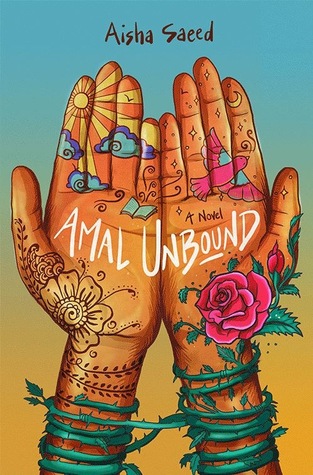
Amal Unbound by Aisha Saeed was just chosen as the Global Read Aloud choice for Middle grade despite it not being released until May, that is how much I believe in this book.
From Goodreads:
Life is quiet and ordinary in Amal’s Pakistani village, but she had no complaints, and besides, she’s busy pursuing her dream of becoming a teacher one day. Her dreams are temporarily dashed when–as the eldest daughter–she must stay home from school to take care of her siblings. Amal is upset, but she doesn’t lose hope and finds ways to continue learning. Then the unimaginable happens–after an accidental run-in with the son of her village’s corrupt landlord, Amal must work as his family’s servant to pay off her own family’s debt.
Life at the opulent Khan estate is full of heartbreak and struggle for Amal–especially when she inadvertently makes an enemy of a girl named Nabila. Most troubling, though, is Amal’s growing awareness of the Khans’ nefarious dealings. When it becomes clear just how far they will go to protect their interests, Amal realizes she will have to find a way to work with others if they are ever to exact change in a cruel status quo, and if Amal is ever to achieve her dreams.
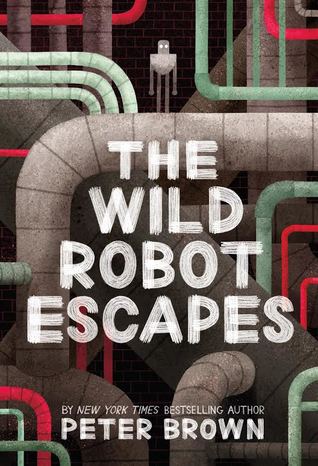
The Wild Robot Escapes by Peter Brown is one of the most perfectly written sequels I have read in a long time.
From Goodreads:
Shipwrecked on a remote, wild island, Robot Roz learned from the unwelcoming animal inhabitants and adapted to her surroundings–but can she survive the challenges of the civilized world and find her way home to Brightbill and the island?

I wanted to love Rebound by Kwame Alexander so much and it turns out it was easy to do. A wonderful prequel to The Crossover that will hook many readers.
From Goodreads:
Before Josh and Jordan Bell were streaking up and down the court, their father was learning his own moves. In this prequel to Newbery Medal winner The Crossover, Chuck Bell takes center stage, as readers get a glimpse of his childhood and how he became the jazz music worshipping, basketball star his sons look up to.

The Night Diary by Veera Hiranandani was a GRA contender for 2018 and rightfully so. Set in India during the partition this book left me captured throughout its journey.
From Goodreads:
It’s 1947, and India, newly independent of British rule, has been separated into two countries: Pakistan and India. The divide has created much tension between Hindus and Muslims, and hundreds of thousands are killed crossing borders.
Half-Muslim, half-Hindu twelve-year-old Nisha doesn’t know where she belongs, or what her country is anymore. When Papa decides it’s too dangerous to stay in what is now Pakistan, Nisha and her family become refugees and embark first by train but later on foot to reach her new home. The journey is long, difficult, and dangerous, and after losing her mother as a baby, Nisha can’t imagine losing her homeland, too. But even if her country has been ripped apart, Nisha still believes in the possibility of putting herself back together.

While I will admit to being more of a cat person than a dog person, Sarah Albee’s newest book Dog Days of History almost convinced me to rethink my allegiance.
From Goodreads:
What is it we love about dogs so much? From ancient times to the present, dogs have guarded us, worked with us, marched off to war with us, and of course, just sat on the couch with us for a cuddle. Throughout the course of human history, this partnership deepened from dogs doing a service into friendship. Dogs have been by our side through it all, and this book tracks our common story from wild wolves in ancient civilizations to modern-day breeds, highlighting famous pooches of the past and present along the way.

Serious, yet funny at the same time Greetings From Witness Protection by Jake Burt was an easy story to like and recommend.
From Goodreads:
Nicki Demere is an orphan and a pickpocket. She also happens to be the U.S. Marshals’ best bet to keep a family alive. . . .
The marshals are looking for the perfect girl to join a mother, father, and son on the run from the nation’s most notorious criminals. After all, the bad guys are searching for a family with one kid, not two, and adding a streetwise girl who knows a little something about hiding things may be just what the marshals need.
Nicki swears she can keep the Trevor family safe, but to do so she’ll have to dodge hitmen, cyberbullies, and the specter of standardized testing, all while maintaining her marshal-mandated B-minus average. As she barely balances the responsibilities of her new identity, Nicki learns that the biggest threats to her family’s security might not lurk on the road from New York to North Carolina, but rather in her own past.

Jewell Parker Rhodes’ Ghost Boys is a must read, must contemplate, must share.
From Goodreads:
Twelve-year-old Jerome is shot by a police officer who mistakes his toy gun for a real threat. As a ghost, he observes the devastation that’s been unleashed on his family and community in the wake of what they see as an unjust and brutal killing.
Soon Jerome meets another ghost: Emmett Till, a boy from a very different time but similar circumstances. Emmett helps Jerome process what has happened, on a journey towards recognizing how historical racism may have led to the events that ended his life. Jerome also meets Sarah, the daughter of the police officer, who grapples with her father’s actions.
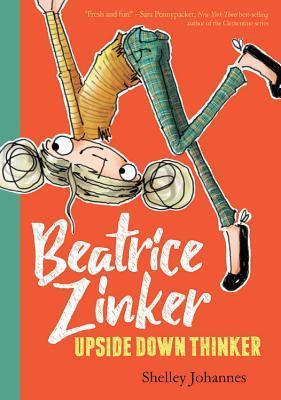
For earlier readers, Beatrice Zinker, Upside Down Thinker by Shelley Johannes is a sure winner featuring a character that sees the world just a little bit different.
From Goodreads:
Hanging from trees by her knees, doing handstands . . . for Beatrice Zinker, upside down works every time. She was definitely upside down when she and her best friend, Lenny, agreed to wear matching ninja suits on the first day of third grade. But when Beatrice shows up at school dressed in black, Lenny arrives with a cool new outfit and a cool new friend. Even worse, she seems to have forgotten all about the top-secret operation they planned!
Favorite Young Adult
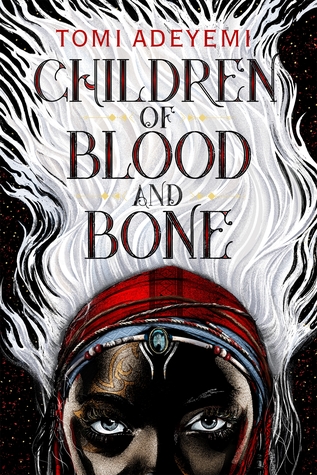
Children of Blood and Bone by Tomi Adeyemi is a must read; fantastic world building and narrative action that leaves you begging for the second book to come out soon!
From Goodreads:
They killed my mother.
They took our magic.
They tried to bury us.
Now we rise.
Zélie Adebola remembers when the soil of Orïsha hummed with magic. Burners ignited flames, Tiders beckoned waves, and Zélie’s Reaper mother summoned forth souls.
But everything changed the night magic disappeared. Under the orders of a ruthless king, maji were killed, leaving Zélie without a mother and her people without hope.
Now Zélie has one chance to bring back magic and strike against the monarchy. With the help of a rogue princess, Zélie must outwit and outrun the crown prince, who is hell-bent on eradicating magic for good.
Danger lurks in Orïsha, where snow leoponaires prowl and vengeful spirits wait in the waters. Yet the greatest danger may be Zélie herself as she struggles to control her powers and her growing feelings for an enemy.
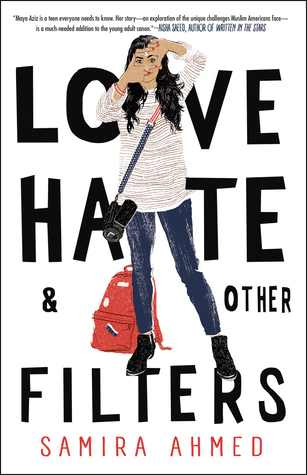
Love, Hate, and Other Filters by Samira Ahmed was just chosen as the Global Read Aloud book for YA – enough said.
From Goodreads:
American-born seventeen-year-old Maya Aziz is torn between worlds. There’s the proper one her parents expect for their good Indian daughter: attending a college close to their suburban Chicago home, and being paired off with an older Muslim boy her mom deems “suitable.” And then there is the world of her dreams: going to film school and living in New York City—and maybe (just maybe) pursuing a boy she’s known from afar since grade school, a boy who’s finally falling into her orbit at school.
There’s also the real world, beyond Maya’s control. In the aftermath of a horrific crime perpetrated hundreds of miles away, her life is turned upside down. The community she’s known since birth becomes unrecognizable; neighbors and classmates alike are consumed with fear, bigotry, and hatred. Ultimately, Maya must find the strength within to determine where she truly belongs.

Reminding me in all of the best ways of Piecing Me Together by Rene Watson, The Poet X by Elizabeth Acevedo is a beautiful consideration of what it means to be a female growing into her own skin.
From Goodreads:
Xiomara Batista feels unheard and unable to hide in her Harlem neighborhood. Ever since her body grew into curves, she has learned to let her fists and her fierceness do the talking.
But Xiomara has plenty she wants to say, and she pours all her frustration and passion onto the pages of a leather notebook, reciting the words to herself like prayers—especially after she catches feelings for a boy in her bio class named Aman, who her family can never know about. With Mami’s determination to force her daughter to obey the laws of the church, Xiomara understands that her thoughts are best kept to herself.
So when she is invited to join her school’s slam poetry club, she doesn’t know how she could ever attend without her mami finding out, much less speak her words out loud. But still, she can’t stop thinking about performing her poems.
Because in the face of a world that may not want to hear her, Xiomara refuses to be silent.

One of Us is Lying by Karen M. McManus has shifted from the hands of one student to the next since I booktalked it more than a month ago. It is one of the most requested books in our classrooms.
From Goodreads:
Pay close attention and you might solve this.
On Monday afternoon, five students at Bayview High walk into detention.
Bronwyn, the brain, is Yale-bound and never breaks a rule.
Addy, the beauty, is the picture-perfect homecoming princess.
Nate, the criminal, is already on probation for dealing.
Cooper, the athlete, is the all-star baseball pitcher.
And Simon, the outcast, is the creator of Bayview High’s notorious gossip app.
Only, Simon never makes it out of that classroom. Before the end of detention, Simon’s dead. And according to investigators, his death wasn’t an accident. On Monday, he died. But on Tuesday, he’d planned to post juicy reveals about all four of his high-profile classmates, which makes all four of them suspects in his murder. Or are they the perfect patsies for a killer who’s still on the loose?
Everyone has secrets, right? What really matters is how far you would go to protect them.”

While technically Dread Nation by Justina Ireland is not out yet, it will be in just a few weeks and it is so worth your pre-ordering. Zombies, history, social justice and a radical butt-kicking female lead character, yes please.
From Goodreads:
Jane McKeene was born two days before the dead began to walk the battlefields of Gettysburg and Chancellorsville—derailing the War Between the States and changing America forever. In this new nation, safety for all depends on the work of a few, and laws like the Native and Negro Reeducation Act require certain children attend combat schools to learn to put down the dead. But there are also opportunities—and Jane is studying to become an Attendant, trained in both weaponry and etiquette to protect the well-to-do. It’s a chance for a better life for Negro girls like Jane. After all, not even being the daughter of a wealthy white Southern woman could save her from society’s expectations.
But that’s not a life Jane wants. Almost finished with her education at Miss Preston’s School of Combat in Baltimore, Jane is set on returning to her Kentucky home and doesn’t pay much mind to the politics of the eastern cities, with their talk of returning America to the glory of its days before the dead rose. But when families around Baltimore County begin to go missing, Jane is caught in the middle of a conspiracy, one that finds her in a desperate fight for her life against some powerful enemies. And the restless dead, it would seem, are the least of her problems.

You Bring the Distant Near by Mitali Perkins is a book that deserves to be read and shared with others. An intricate weaving of family and how we grow apart to only grow together.
From Goodreads:
Five girls. Three generations. One great American love story. You Bring the Distant Near explores sisterhood, first loves, friendship, and the inheritance of culture–for better or worse. Ranee, worried that her children are losing their Indian culture; Sonia, wrapped up in a forbidden biracial love affair; Tara, seeking the limelight to hide her true self; Shanti, desperately trying to make peace in the family; Anna, fighting to preserve her Bengali identity–award-winning author Mitali Perkins weaves together a sweeping story of five women at once intimately relatable and yet entirely new.

Both heartwrenching and heartstopping Girl Made of Stars by Ashley Herring Blake was thought-provoking and also, unfortunately, incredibly timely in our culture.
From Goodreads:
“I need Owen to explain this. Because yes, I do know that Owen would never do that, but I also know Hannah would never lie about something like that.”
Mara and Owen are about as close as twins can get. So when Mara’s friend Hannah accuses Owen of rape, Mara doesn’t know what to think. Can the brother she loves really be guilty of such a violent crime? Torn between the family she loves and her own sense of right and wrong, Mara is feeling lost, and it doesn’t help that things have been strained with her ex and best friend since childhood, Charlie.
As Mara, Hannah, and Charlie navigate this new terrain, Mara must face a trauma from her own past and decide where Charlie fits in her future.

Who would have thought that Speak by Laurie Halse Anderson could be even better, it turns out that the graphic novel took it to another soaring height.
From Goodreads:
From the first moment of her freshman year at Merryweather High, Melinda knows this is a big fat lie, part of the nonsense of high school. She is friendless–an outcast–because she busted an end-of-summer party by calling the cops, so now nobody will talk to her, let alone listen to her. Through her work on an art project, she is finally able to face what really happened that night: She was raped by an upperclassman, a guy who still attends Merryweather and is still a threat to her.

Not sure whether to categorize Mary’s Monster by Lita Judge as YA, but it is gorgeous and also making its rounds quickly through the reading lives of our students.
From Goodreads:
Mary Shelley first began penning Frankenstein as part of a dare to write a ghost story, but the seeds of that story were planted long before that night. Mary, just nineteen years old at the time, had been living on her own for three years and had already lost a baby days after birth. She was deeply in love with famed poet Percy Bysshe Shelley, a mad man who both enthralled and terrified her, and her relationship with him was rife with scandal and ridicule. But rather than let it crush her, Mary fueled her grief, pain, and passion into a book that the world has still not forgotten 200 years later.
We live in a time where it seems the books being published just get better and better, and I cannot wait to see what the next quarter of the year will bring. Happy reading to all!




